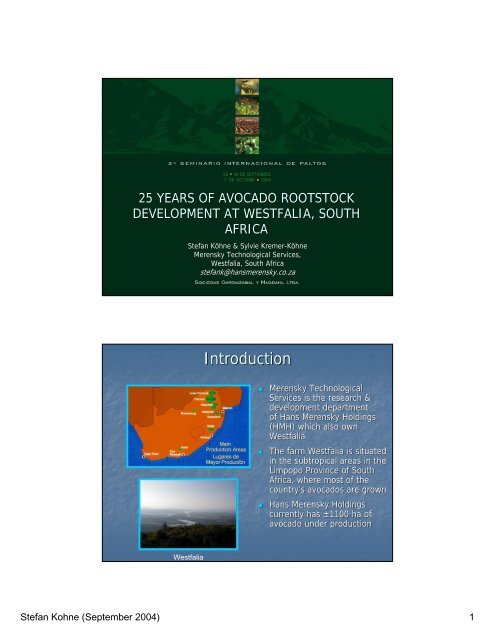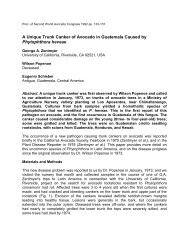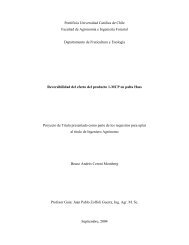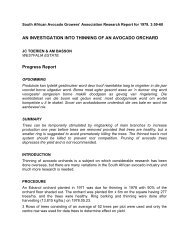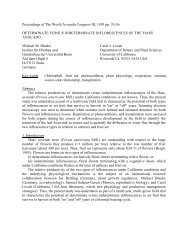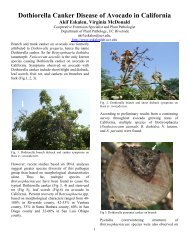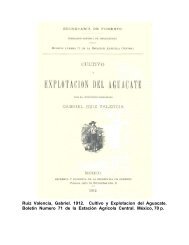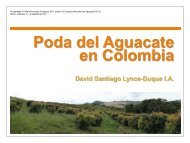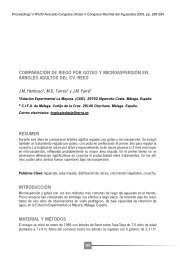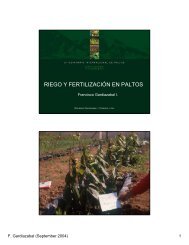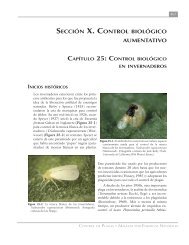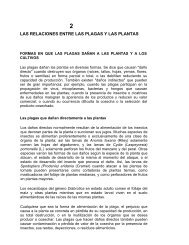25 Years of Avocado Rootstock Development at Westfalia, South ...
25 Years of Avocado Rootstock Development at Westfalia, South ...
25 Years of Avocado Rootstock Development at Westfalia, South ...
Create successful ePaper yourself
Turn your PDF publications into a flip-book with our unique Google optimized e-Paper software.
<strong>25</strong> YEARS OF AVOCADO ROOTSTOCK<br />
DEVELOPMENT AT WESTFALIA, SOUTH<br />
AFRICA<br />
Stefan Köhne hne & Sylvie Kremer-Köhne<br />
Kremer hne<br />
Merensky Technological Services,<br />
<strong>Westfalia</strong>, <strong>Westfalia</strong>,<br />
<strong>South</strong> Africa<br />
stefank@hansmerensky.co.za<br />
stefank@hansmerensky.co.za<br />
<strong>Westfalia</strong><br />
Introduction<br />
�� Merensky Technological<br />
Services is the research &<br />
development department<br />
<strong>of</strong> Hans Merensky Holdings<br />
(HMH) which also own<br />
<strong>Westfalia</strong><br />
�� The farm <strong>Westfalia</strong> is situ<strong>at</strong>ed<br />
in the subtropical areas in the<br />
Limpopo Province <strong>of</strong> <strong>South</strong><br />
Africa, where most <strong>of</strong> the<br />
country’s country s avocados are grown<br />
�� Hans Merensky Holdings<br />
currently has ±1100 1100 ha <strong>of</strong><br />
avocado under production<br />
Stefan Kohne (September 2004) 1
1. <strong>Westfalia</strong> rootstocks:<br />
from seedling to super clonal<br />
In the 1930‘s, Dr Hans Merensky<br />
planted first avocado orchards <strong>at</strong><br />
<strong>Westfalia</strong>. Many years l<strong>at</strong>er, the<br />
Hans Merensky Found<strong>at</strong>ion was<br />
established with the aim ...<br />
“... to promote and assist in the<br />
development <strong>of</strong> the resources <strong>of</strong><br />
<strong>South</strong> Africa and neighbouring<br />
territories - particularly such<br />
n<strong>at</strong>ural resources as soil,<br />
w<strong>at</strong>er, minerals, flora and<br />
fauna and welfare <strong>of</strong> the<br />
inhabitants; more specifically by<br />
research and demonstr<strong>at</strong>ion<br />
and through the correl<strong>at</strong>ion and<br />
applic<strong>at</strong>ion <strong>of</strong> scientific<br />
knowledge.“<br />
�� West Indian & Mexican race<br />
seeds introduced ± 100<br />
years ago<br />
�� By the l<strong>at</strong>e 1920’s 1920 s mainly<br />
Mexican seedlings were<br />
used as rootstocks<br />
�� These were more hardy and<br />
slightly less vigorous than<br />
the West Indian seedling<br />
trees<br />
Stefan Kohne (September 2004) 2
1950’s 1950<br />
�� Gu<strong>at</strong>emalan seedling rootstocks used<br />
(Edranol & Nabal) Nabal<br />
�� High susceptibility to Phytophthora Phytophthora cinnamomi cinnamomi resulted<br />
in poor yields<br />
�� Orchard life ±12 12 years<br />
1960’s 1960<br />
�� Duke seedlings used as rootstocks<br />
�� Plantings <strong>at</strong> ±100 100<br />
trees/ha<br />
�� Thinned to ±50 50 trees/ ha<br />
to accommod<strong>at</strong>e very<br />
large trees<br />
�� Very low yields / ha due<br />
to wide open spaces<br />
between & inside trees<br />
Stefan Kohne (September 2004) 3
The devast<strong>at</strong>ion caused by Pc in avocado orchards in many<br />
countries was the turning point & research focused on<br />
finding resistant or tolerant rootstocks<br />
California<br />
�� The predictability <strong>of</strong><br />
genetically uniform, root rot<br />
tolerant, productive trees was<br />
a distinct advantage over the<br />
variability <strong>of</strong> the seedling<br />
rootstocks<br />
�� California looked to clonal<br />
rootstocks for the solution… solution<br />
and we looked to California<br />
�� Hence clonal rootstocks were<br />
introduced into SA from<br />
California in the l<strong>at</strong>e 1970’s, 1970 s,<br />
along with some costly<br />
lessons to be learnt… learnt<br />
<strong>Westfalia</strong> had land to develop & these Pc tolerant clonals<br />
seemed just the answer<br />
Stefan Kohne (September 2004) 4
Duke 6<br />
Duke 7<br />
Survivor Trees<br />
�� In the early 1980’s 1980 s Hass<br />
orchards with altern<strong>at</strong>e rows <strong>of</strong><br />
Duke 6 & Duke 7 rootstocks<br />
were planted on a large<br />
commercial scale<br />
�� Both rootstocks were said to be<br />
tolerant to Pc & non-vigorous<br />
non vigorous<br />
�� After 2-3 2 3 years trees on Duke 6<br />
started dying showing<br />
symptoms <strong>of</strong> stem pitting<br />
�� The disease was never identified<br />
but thought to have been<br />
caused by infected Duke 6<br />
budwood<br />
�� About 100 ha <strong>of</strong> orchards were<br />
destroyed along with the mother<br />
trees & Duke 6 no longer exists<br />
in <strong>South</strong> Africa<br />
�� Duke 7 turned out to be a<br />
successful rootstock for the time<br />
being, providing uniform,<br />
productive & reasonably healthy<br />
orchards<br />
�� In the l<strong>at</strong>e 1970’s, 1970 s, several extraordinarily healthy &<br />
productive survivor trees were identified in diseased<br />
seedling orchards on <strong>Westfalia</strong> Farms<br />
�� To induce the rootstock the Fuerte scion was cut <strong>of</strong>f<br />
from the best performing <strong>of</strong> these trees<br />
�� The rootstock shoots were then used to produce clonal<br />
trees th<strong>at</strong> were introduced into the rootstock evalu<strong>at</strong>ion<br />
program<br />
Stefan Kohne (September 2004) 5
�� The 1980’s 1980 s saw <strong>Westfalia</strong>’s <strong>Westfalia</strong> revolutionary phosphorous acid injections<br />
bringing gre<strong>at</strong> relief as a means to control root rot<br />
�� This led to a planting boom & further rootstocks could be introduced introduced<br />
for<br />
evalu<strong>at</strong>ion in the search for a superior rootstock<br />
�� G6, G755, Thomas, D9 & Barr Duke were brought in from California<br />
Super Trees<br />
While evalu<strong>at</strong>ing these imported rootstocks,<br />
<strong>Westfalia</strong> also identified super trees with<br />
continually high yields in seedling orchards<br />
Stefan Kohne (September 2004) 6
�� Some <strong>of</strong> these super trees<br />
could be manipul<strong>at</strong>ed to<br />
produce suckers from the<br />
rootstock<br />
�� The suckers were used to<br />
make clonal copies <strong>of</strong> these<br />
trees<br />
�� These copies were then<br />
introduced into the<br />
rootstock evalu<strong>at</strong>ion<br />
program alongside the<br />
imported rootstocks<br />
Subsequently various rootstock test sites were<br />
established <strong>at</strong> <strong>Westfalia</strong><br />
Stefan Kohne (September 2004) 7
Hass / Duke 7 Hass / G755 (Martin Grande)<br />
Kremer-Köhne & Köhne, 1992<br />
Stefan Kohne (September 2004) 8
ootstocks in years 6-8, averaged over three sites <strong>at</strong><br />
<strong>Westfalia</strong> Est<strong>at</strong>e (Roe, Morudu & Köhne, 1999)<br />
0.5<br />
0.4<br />
0.3<br />
0.2<br />
0.1<br />
kg / cm2 trunk area Yield efficiency <strong>of</strong> Hass on different Californian clonal<br />
0<br />
<strong>Rootstock</strong><br />
Duke 6<br />
G6<br />
G755<br />
Thomas<br />
D9<br />
Barr Duke<br />
Duke 7<br />
Duke 7 Barr Duke D9 Thomas<br />
First Gener<strong>at</strong>ion Clonal <strong>Rootstock</strong>s<br />
Results in <strong>South</strong> Africa<br />
Stem pitting and die back<br />
Tolerance to Pc similar to Duke 7 but less productive<br />
Moder<strong>at</strong>e resistance with very poor production &<br />
excessive vigor<br />
Good tolerance to Pc but disappointing yields<br />
Very slow growth r<strong>at</strong>e resulting in small trees, yields<br />
s<strong>at</strong>isfactory but not superior to Duke 7<br />
Lower vigor than Duke 7 with production only slightly<br />
higher than Thomas<br />
Best clonal rootstock in the 1980’s 1980 s and 1990’s 1990<br />
Stefan Kohne (September 2004) 9
The trend was shifting away from low density low yielding<br />
Fuerte to high density high yielding Hass. Vigor was no<br />
longer a concern as pruning & growth retardants were<br />
being introduced. These factors had to be considered<br />
when evalu<strong>at</strong>ing new rootstocks.<br />
$$$<br />
So wh<strong>at</strong> was required from<br />
this superior rootstock we<br />
were looking out for?<br />
�� High yields <strong>of</strong> Hass scion<br />
�� High tolerance / resistance<br />
to Pc, excellent tree health<br />
�� Good initial vigor to<br />
establish quickly & easily<br />
�� Uniformity in the orchards<br />
�� Easy rootablity in the<br />
nursery & good graft take<br />
Stefan Kohne (September 2004) 10
Effect <strong>of</strong> grafting on susceptibility <strong>of</strong><br />
rootstocks to Phytophthora Phytophthora cinnamomi cinnamomi<br />
<strong>Rootstock</strong><br />
Duke 7<br />
G6<br />
G755<br />
Grafted to Hass<br />
15.7 a 1<br />
12.5 abc<br />
11.6 bcd<br />
Ungrafted<br />
Length <strong>of</strong> lesion (mm) caused by P. P. cinnamomi cinnamomi<br />
8.5 de<br />
7.1 ef<br />
Stefan Kohne (September 2004) 11<br />
4.1 f<br />
1 Mean values in each column followed by identical letters are not significantly<br />
different <strong>at</strong> P=0.05 according to Duncan’s Multiple Range Test.<br />
D<strong>at</strong>a taken from Botha & Kotze (1989)<br />
MTS <strong>Rootstock</strong> Breeding & Selection Program<br />
to gener<strong>at</strong>e new rootstocks<br />
�� Breeding Block : 20 rootstocks Year 1<br />
�� Seedlings screened in Pc mistbed Year 2<br />
�� 10 copies / selection re-tested re tested Year 4<br />
�� Best selections (with Hass) planted in field trial<br />
Year 10<br />
�� Commercial recommend<strong>at</strong>ion Year 20<br />
�� First commercial plantings producing Year <strong>25</strong>
Promising Selections Cloned<br />
<strong>Rootstock</strong> Field Evalu<strong>at</strong>ion<br />
�� To d<strong>at</strong>e >30 rootstocks evalu<strong>at</strong>ed from many countries<br />
�� Origin <strong>of</strong> rootstocks:<br />
�� selections from MTS Breeding & Selection Program<br />
�� imported plant m<strong>at</strong>erial<br />
�� SA rootstocks <strong>of</strong> survivor & super trees<br />
Stefan Kohne (September 2004) 12
Yield (t/ha)<br />
100<br />
80<br />
60<br />
40<br />
20<br />
0<br />
<strong>Rootstock</strong> Field Evalu<strong>at</strong>ion<br />
Groenklo<strong>of</strong><br />
�� 24 to 30 trees /<br />
rootstock planted in<br />
randomised block design<br />
�� All trees grafted to Hass<br />
�� Initially Duke 7 used as<br />
control, now Dusa Dusa<br />
(Merensky 2) used<br />
�� Evalu<strong>at</strong>ed for minimum<br />
<strong>of</strong> 6 years<br />
�� Orchards established in<br />
1996, 1998, 2000, 2003<br />
<strong>25</strong> <strong>Years</strong> <strong>of</strong> <strong>Rootstock</strong> <strong>Development</strong><br />
Cumul<strong>at</strong>ive yields <strong>of</strong> Hass trees<br />
on <strong>Westfalia</strong> rootstocks (1996-2004)<br />
Duke 7 Merensky 1 Dusa<br />
�� ±US US $2 million invested in<br />
the program to d<strong>at</strong>e<br />
�� Dusa Dusa (Merensky 2)<br />
released to several<br />
countries recently<br />
�� More than 200,000 Dusa Dusa<br />
(Merensky 2) planted in<br />
<strong>South</strong> Africa & USA in the<br />
past 2 years<br />
Stefan Kohne (September 2004) 13
2. Commercial Hass plantings on<br />
Dusa (Merensky 2) rootstock in<br />
<strong>South</strong> Africa<br />
Hass / Duke 7<br />
Hass / Dusa<br />
(Merensky 2)<br />
Altern<strong>at</strong>e rows <strong>of</strong> Hass / Dusa & Hass / Duke 7<br />
<strong>at</strong> <strong>Westfalia</strong>, two years after planting<br />
Stefan Kohne (September 2004) 14
Hass / Dusa two years from planting<br />
Feedback from Kakuzi<br />
Stefan Kohne (September 2004) 15
<strong>25</strong>0<br />
200<br />
150<br />
100<br />
50<br />
0<br />
3. <strong>Rootstock</strong> field plots in California<br />
(Menge Menge et et al.* al.*<br />
2004)<br />
*J.A. Menge, G.A. Zentmyer, B. McKee, E. Pond, M. Crowley, M. Clegg,<br />
B. Faber, G. Bender, P. Mauk, M.L. Arpaia, T. Chao, V. Ashworth<br />
“First Gener<strong>at</strong>ion” <strong>Rootstock</strong>s<br />
Thomas Duke 7 Borchard Topa Topa Toro Canyon G1033 D9 G755A G755C G755B<br />
2 years after planting 3 years after planting<br />
4 years after planting 5 years after planting<br />
Stefan Kohne (September 2004) 16
“Second Gener<strong>at</strong>ion” <strong>Rootstock</strong>s in California<br />
�� 30 field plots, about 6000 trees in total<br />
�� Dusa Dusa (Merensky 2) was introduced into California as<br />
part <strong>of</strong> a 20 year study on Pc resistant, high yielding,<br />
saline tolerant rootstocks<br />
�� Year 9 <strong>of</strong> 20 / 2001 : “It It appears we have several<br />
rootstocks performing better than our standard resistant<br />
variety, Thomas. These are Merensky 2 (SA), Merensky<br />
1 (SA), Uzi … We have obtained first yield results and<br />
Merensky 2 appears to provide excellent yields & has<br />
been released to growers.” growers. (Menge Menge et et al., al. , 2001)<br />
Dusa (Merensky 2) planted in<br />
Phytophthora-infested soil,<br />
California 2002 (3 years old)<br />
Stefan Kohne (September 2004) 17
Fruit yield <strong>of</strong> Hass avocados growing on various rootstocks<br />
in Escondido, CA, 2002<br />
<strong>Rootstock</strong><br />
Rio Frio<br />
Zentmyer<br />
Merensky II (Dusa) (Dusa<br />
Uzi<br />
Merensky I<br />
Spencer seedling<br />
Steddom<br />
Thomas<br />
VC241<br />
Leo<br />
Spencer clonal<br />
G755A<br />
Guillemet<br />
Duke 7<br />
<strong>Rootstock</strong><br />
Merensky I<br />
VC241<br />
Rio Frio<br />
Zentmyer<br />
G755A<br />
Yield/tree (kg)<br />
24.7a<br />
21.0ab<br />
18.6ab<br />
18.3ab<br />
18.0ab<br />
17.0ab<br />
16.6abc<br />
15.0abc<br />
12.2abcd<br />
11.3bcd<br />
11.3bcd<br />
9.6bcd<br />
8.4bcd<br />
3.9cd<br />
Individual fruit weight (kg)<br />
0.19abc<br />
0.18abc<br />
0.16abc<br />
0.17abc<br />
0.17abc<br />
0.17abc<br />
0.20abc<br />
0.15abc<br />
0.14bcd<br />
0.20abc<br />
0.13bcd<br />
Stefan Kohne (September 2004) 18<br />
0.23a<br />
0.21ab<br />
0.12cd<br />
R<strong>at</strong>ing <strong>of</strong> Hass avocado on various rootstocks<br />
in Escondido, CA, 2003.<br />
Merensky II (Dusa) (Dusa<br />
Spencer seedling<br />
Uzi<br />
Steddom<br />
Thomas<br />
Leo<br />
Guillemet<br />
Duke 7<br />
Spencer clonal<br />
Tree r<strong>at</strong>ing<br />
(0-5; (0 5; 5=dead)<br />
0.00d<br />
0.06d<br />
0.07d<br />
0.07d<br />
0.18d<br />
0.36d<br />
0.38d<br />
0.39d<br />
0.47cd<br />
0.77bcd<br />
0.83bcd<br />
1.34bc<br />
1.44b<br />
1.69b<br />
Canopy volume<br />
Cu ft<br />
551ab<br />
281efgh<br />
362efcd<br />
410bcde<br />
532abc<br />
263efgh<br />
669a<br />
478bcd<br />
367cdef<br />
274efgh<br />
190ghi<br />
127hi<br />
211fghi<br />
322defg<br />
Trunk diameter<br />
cm<br />
10.7a<br />
8.0abc<br />
8.7abc<br />
9.2ab<br />
9.4ab<br />
6.9bc<br />
10.6a<br />
8.6abc<br />
8.4abc<br />
7.3abc<br />
6.2bc<br />
8.8abc<br />
5.3c<br />
7.0bc
Leaf analysis <strong>of</strong> chlorine on Hass avocado growing<br />
on various rootstocks in Escondido, CA, 2002<br />
<strong>Rootstock</strong>s<br />
Uzi<br />
G755A<br />
Steddom<br />
Leo<br />
Thomas<br />
Spencer clonal<br />
Zentmyer<br />
Guillemet<br />
Chlorine<br />
(ueq/g -12 12 )<br />
16.79a<br />
13.21b<br />
12.96b<br />
12.77b<br />
11.83bc<br />
10.79bcd<br />
10.78bcd<br />
9.74cde<br />
<strong>Rootstock</strong>s<br />
VC241<br />
Spencer seedling<br />
Duke 7<br />
Merensky I<br />
Poly N<br />
Merensky II (Dusa) (Dusa<br />
Rio Frio<br />
Chlorine<br />
(ueq/g -12 12 )<br />
8.92de<br />
4.51fg<br />
4.35fg<br />
Stefan Kohne (September 2004) 19<br />
8.26e<br />
8.06e<br />
5.10f<br />
2.39g
Effect <strong>of</strong> various rootstocks on Hass avocado<br />
yield <strong>at</strong> <strong>South</strong> Coast Field St<strong>at</strong>ion, Orange<br />
Co., 2001 and 7-year 7 year-average. average.<br />
<strong>Rootstock</strong><br />
Dusa Dusa<br />
Duke 7<br />
Thomas<br />
UCR 2003<br />
Borchard<br />
Duke 9<br />
Queretaro<br />
Spencer<br />
UCR 2011<br />
CRI-71 CRI 71<br />
2001<br />
85.03 a<br />
68.92 b<br />
66.84 bc<br />
66.55 bc<br />
59.65 bc<br />
58.34 bcd<br />
54.38 bcd<br />
52.54 cd<br />
43.73 d<br />
9.61 e<br />
Yield/tree (kg)<br />
7-year year-average average<br />
27.05 a<br />
22.88 b<br />
18.20 cde<br />
21.50 bc<br />
19.40 bcd<br />
18.16 cde<br />
16.78 de<br />
12.82 f<br />
15.54 ef<br />
3.04 g<br />
• Only release <strong>of</strong> UCR tested avocado rootstocks since 1994:<br />
Dusa (Merensky 2)<br />
• Brokaw Nursery California: Master Licensee <strong>of</strong> Dusa<br />
Stefan Kohne (September 2004) 20
The Future<br />
�� The avocado rootstock Dusa Dusa has been imported into Chile and is<br />
presently propag<strong>at</strong>ed by licensed nurseries. The first plantings <strong>of</strong> the<br />
rootstock Dusa Dusa are imminent and we are hopeful th<strong>at</strong> the superior results<br />
achieved in <strong>South</strong> Africa and California will be repe<strong>at</strong>ed in Chile. Chile.<br />
�� Not only have we through selection and thorough testing released a proven<br />
superior rootstock, Dusa Dusa (Merensky 2), but we are striving to assist the<br />
avocado industry with even better altern<strong>at</strong>ives<br />
�� Presently Merensky Technological Services have 5 new promising clonal clonal<br />
rootstocks under field evalu<strong>at</strong>ion <strong>at</strong> <strong>Westfalia</strong>.<br />
�� We look forward to sharing our exciting breakthroughs with you in in<br />
the future<br />
Merensky Technological Services:<br />
Our Technology Bears Fruit!<br />
THANK YOU<br />
Stefan Kohne (September 2004) 21
Growing with clonals : caution & care<br />
�<br />
�<br />
Mpumalanga<br />
Hass / Duke 7 both planted Dec 2002 – photo taken March 2003<br />
Stefan Kohne (September 2004) 22
Plant <strong>at</strong> correct depth<br />
Don’t over irrig<strong>at</strong>e<br />
�<br />
�<br />
Stefan Kohne (September 2004) 23<br />
20cm
Protection from buck & insects<br />
Protection from sunburn<br />
Stefan Kohne (September 2004) 24
Apply mulch Support tree<br />
Chemical control in replant situ<strong>at</strong>ions<br />
Stefan Kohne (September 2004) <strong>25</strong>
<strong>Rootstock</strong><br />
G6<br />
G755<br />
Thomas<br />
D9<br />
Barr Duke<br />
Colin V-33 V 33<br />
Dusa Dusa<br />
(Merensky 2)<br />
Merensky 1<br />
Origin<br />
Seedling<br />
selection<br />
Hybrid<br />
Survivor<br />
tree<br />
Irradi<strong>at</strong>ed<br />
Duke<br />
budwood<br />
Seedling <strong>of</strong><br />
Duke 6<br />
Dwarf scion<br />
cultivar<br />
<strong>Westfalia</strong><br />
<strong>Westfalia</strong><br />
Results<br />
Tolerance to Pc similar to Duke 7 but less productive<br />
Moder<strong>at</strong>e resistance with very poor production &<br />
excessive vigor<br />
Good tolerance to Pc but disappointing yields<br />
Very slow growth r<strong>at</strong>e resulting in small trees, yields<br />
s<strong>at</strong>isfactory but not superior to Duke 7<br />
Lower vigor than Duke 7 with production only slightly<br />
higher than Thomas<br />
Used as interstock to impart lower vigor – no growth<br />
retardance noted in <strong>South</strong> African growing conditions<br />
Outperforms Duke 7 in terms <strong>of</strong> Pc tolerance & Hass<br />
production, tolerant to salt, released in 2001<br />
Better Pc tolerance than Duke 7, production promising,<br />
not released<br />
Stefan Kohne (September 2004) 26


